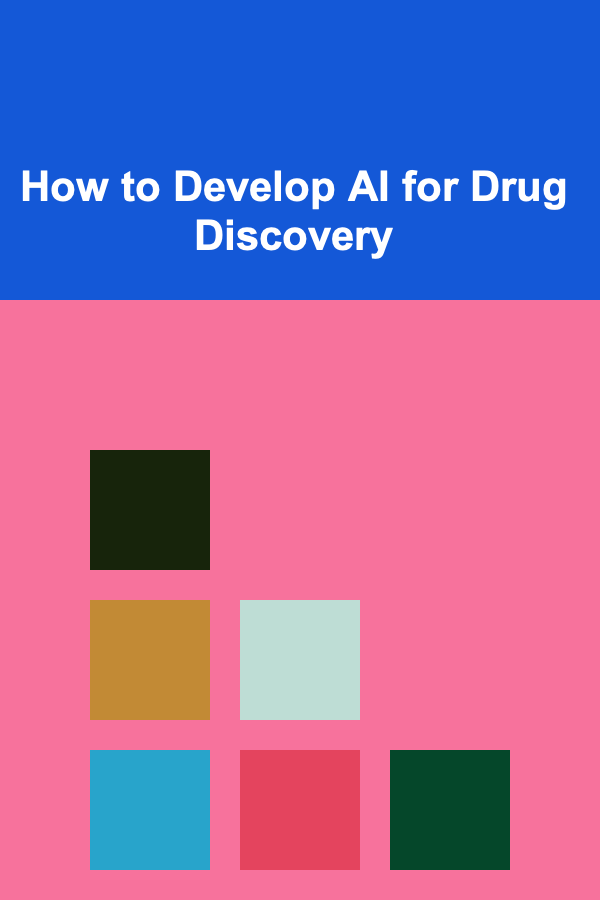
How to Develop AI for Drug Discovery
ebook include PDF & Audio bundle (Micro Guide)
$12.99$11.99
Limited Time Offer! Order within the next:

Artificial intelligence (AI) has made a significant impact in many industries, and one area where it shows tremendous potential is drug discovery. The pharmaceutical industry, traditionally known for its time-consuming, expensive, and often inefficient drug development process, is increasingly turning to AI to improve research, reduce costs, and speed up the development of new medications. In this article, we will explore how to develop AI systems for drug discovery, the challenges involved, the benefits AI brings, and the key considerations when implementing AI in this field.
The Role of AI in Drug Discovery
Drug discovery is a complex, multi-stage process that involves identifying potential drug candidates, testing them, and ensuring they are safe and effective for human use. Traditionally, this process has been labor-intensive and expensive, with many drug candidates failing during clinical trials. The success rate is low, and the costs can run into billions of dollars. AI offers the promise of revolutionizing this process by using advanced algorithms and computational models to speed up the identification of drug candidates, predict drug interactions, and analyze biological data more efficiently.
Key Areas AI Can Enhance in Drug Discovery
- Target Identification and Validation: AI can be used to identify and validate potential drug targets. Through the analysis of vast datasets, AI systems can predict which proteins, genes, or pathways are most likely to be involved in disease processes, providing crucial insights for the development of drugs that target these molecules.
- Drug Screening and Compound Design: AI accelerates the process of drug screening by predicting which compounds are most likely to interact with disease-related targets. Machine learning (ML) models can be trained on data from previous studies to predict the biological activity of new compounds, drastically reducing the time and resources required for experimental screening.
- Predicting Drug Toxicity and Side Effects: One of the key challenges in drug development is predicting the toxicity and potential side effects of new compounds. AI models, using data from previous studies, can help predict these risks early in the development process, reducing the chances of failure in clinical trials.
- Clinical Trials Optimization: AI can be used to optimize clinical trial design and patient recruitment. By analyzing patient data, AI systems can identify the most suitable candidates for clinical trials, ensuring that trials are conducted more efficiently and with a higher likelihood of success.
- Biomarker Discovery: AI can assist in the discovery of biomarkers that can be used to predict disease progression, response to treatment, or patient stratification. Machine learning algorithms can analyze large sets of genomic, proteomic, and other omics data to identify potential biomarkers that are relevant to a particular disease or treatment.
- Repurposing Existing Drugs: AI can help identify new uses for existing drugs by analyzing data from a variety of sources, including clinical trial results, electronic health records, and research publications. This is particularly useful when developing treatments for rare or hard-to-treat diseases.
Steps in Developing AI for Drug Discovery
Developing AI for drug discovery requires a multidisciplinary approach, involving expertise in fields such as data science, bioinformatics, medicinal chemistry, and pharmacology. Below are the key steps involved in developing AI systems for drug discovery.
1. Data Collection and Preprocessing
The foundation of any AI system is data. In the context of drug discovery, this data can come from a variety of sources, including:
- Genomic Data: Information about the genes involved in specific diseases and their mutations.
- Chemical Data: Structural information about existing compounds and their interactions with targets.
- Biological Data: Data about protein expression levels, pathways, and cellular interactions.
- Clinical Data: Patient data, including information about drug efficacy, side effects, and biomarkers.
Data preprocessing is critical for building effective AI models. Raw data may be noisy, incomplete, or contain biases that can hinder the model's performance. Data preprocessing involves cleaning, normalizing, and transforming the data into a format that is suitable for AI algorithms. This may include removing irrelevant features, handling missing values, and ensuring the data is properly labeled.
2. Feature Engineering
Feature engineering is the process of selecting and creating the most relevant features (variables) from raw data that will help the AI system make accurate predictions. In drug discovery, features could include:
- Molecular descriptors (e.g., molecular weight, lipophilicity, and hydrogen bond donors).
- Genetic variations linked to disease.
- Protein-protein interaction data.
- Pathway information that may indicate disease processes.
Feature engineering often requires domain knowledge in biochemistry and pharmacology. By selecting the right features, AI models can learn to identify patterns in the data that are crucial for drug discovery.
3. Model Selection and Training
Once the data is prepared, the next step is to choose the appropriate machine learning algorithms and train the model. In drug discovery, several types of models are commonly used, including:
- Supervised Learning: This involves training models on labeled data (e.g., known drug-target interactions) to make predictions about new, unseen data. Common algorithms include support vector machines (SVM), random forests, and neural networks.
- Unsupervised Learning: In some cases, labeled data may be unavailable, and unsupervised learning techniques like clustering or dimensionality reduction can be used to discover hidden patterns or relationships in the data.
- Reinforcement Learning: This technique can be applied to optimize drug discovery processes, such as compound screening, by learning from interactions with the environment to improve decision-making over time.
The training process involves feeding large datasets into the selected model and adjusting the model parameters to minimize errors in predictions. This process is typically computationally expensive and requires high-performance computing resources.
4. Model Evaluation and Validation
Once the AI model is trained, it needs to be evaluated to ensure its performance is robust and reliable. Several evaluation metrics can be used depending on the task, such as accuracy, precision, recall, and F1 score for classification problems, or mean squared error for regression tasks.
It's essential to validate the model on unseen data to prevent overfitting (where the model performs well on training data but fails to generalize to new data). Cross-validation techniques, such as k-fold cross-validation, can help assess the model's performance more effectively.
5. Deployment and Integration
After developing and validating the AI model, the next step is deployment. In the context of drug discovery, this often involves integrating the AI system into existing workflows, such as high-throughput screening platforms or clinical trial management systems.
AI systems should be designed to work alongside domain experts, such as medicinal chemists and biologists, who can provide insights into the model's predictions and guide the next steps in the drug discovery process. It's important that the AI system provides actionable insights rather than just predictions, allowing scientists to make informed decisions based on the model's output.
Challenges in Developing AI for Drug Discovery
While AI holds great promise in drug discovery, there are several challenges to overcome when developing AI models for this field.
1. Data Quality and Availability
High-quality data is the backbone of AI models, and in drug discovery, this can be a major hurdle. Much of the data is proprietary and fragmented across various databases, making it difficult to access and integrate. Additionally, the data may be noisy, incomplete, or biased, leading to inaccurate models.
2. Complexity of Biological Systems
The human body is a highly complex biological system, and diseases are caused by a multitude of interacting factors. Capturing this complexity in a machine learning model is a difficult task. AI models need to account for various biological processes, such as gene expression, protein folding, and cellular interactions, which can be hard to model accurately.
3. Interpretability and Transparency
One of the challenges with AI, particularly deep learning, is the "black box" nature of the models. While these models can make accurate predictions, understanding how they arrive at those predictions can be difficult. This lack of transparency can be a barrier to trust, especially in the healthcare industry, where the stakes are high.
4. Regulatory Approval and Validation
In the pharmaceutical industry, drugs must go through a rigorous process of clinical testing and regulatory approval before they can be marketed. While AI can assist in identifying promising drug candidates, it cannot replace the need for human oversight and regulatory validation. AI-generated predictions must be carefully reviewed and validated by human experts before any clinical trials begin.
5. Integration with Traditional Drug Discovery
AI is not a replacement for traditional drug discovery methods; rather, it is a complementary tool that can enhance and accelerate the process. Integrating AI into existing workflows and ensuring that AI models can work seamlessly with traditional methods is a major challenge. There may also be resistance from scientists and clinicians who are accustomed to traditional approaches.
Conclusion
Developing AI for drug discovery has the potential to revolutionize the pharmaceutical industry by speeding up the process, reducing costs, and identifying more effective drug candidates. By leveraging AI in areas like target identification, drug screening, and clinical trial optimization, researchers can significantly enhance the efficiency and success rate of drug development. However, challenges such as data quality, biological complexity, and model interpretability must be addressed before AI can fully realize its potential in drug discovery.
With the right infrastructure, collaboration between AI researchers and domain experts, and careful validation of AI predictions, AI has the power to transform the way we discover new drugs and improve human health.
Reading More From Our Other Websites
- [Personal Financial Planning 101] How to Budget for Big Life Events (Wedding, Baby, etc.)
- [Home Cleaning 101] How to Deep Clean Your Sofa and Upholstery
- [Home Pet Care 101] The Pros and Cons of Raw Food Diets for Pets
- [Personal Investment 101] How to Invest in Commodities Like Oil, Coffee, and Wheat
- [Whitewater Rafting Tip 101] From River to Results: The Physical Benefits of Regular Rafting Sessions
- [Polymer Clay Modeling Tip 101] From Concept to Creation: A Step‑by‑Step Guide to Sculpting Miniature Figurines in Polymer Clay
- [Rock Climbing Tip 101] Behind the Lens: How Documentary Filmmakers Capture the Thrill of Climbing
- [Home Party Planning 101] How to Set Up a DIY Photo Booth for Your Home Party
- [Organization Tip 101] How to Use Technology to Track Toy Inventory
- [Organization Tip 101] How to Organize Your Home Based on Feng Shui Principles

How to Build a Profitable Online Store and Make Money from Home
Read More
How to Choose Affordable Rugs to Elevate Your Space
Read More
How to Create a Paperwork Organization System for Your Home
Read More
How to Cut Your Monthly Utility Bills with Simple Home Adjustments
Read More
How to Make the Most of Your Apartment's Limited Space
Read More
How To Find New Artists in the Hyperpop Scene
Read MoreOther Products

How to Build a Profitable Online Store and Make Money from Home
Read More
How to Choose Affordable Rugs to Elevate Your Space
Read More
How to Create a Paperwork Organization System for Your Home
Read More
How to Cut Your Monthly Utility Bills with Simple Home Adjustments
Read More
How to Make the Most of Your Apartment's Limited Space
Read More